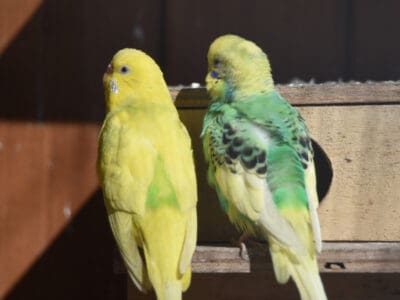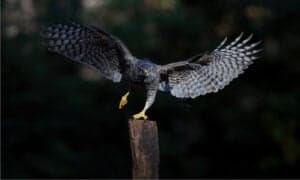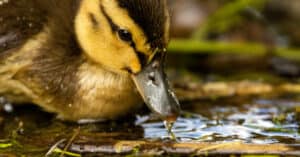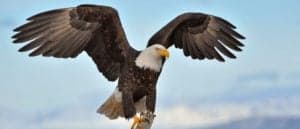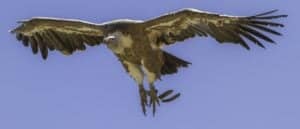What Do Swans Eat? 18 Foods They’ll Consume
Swans are interesting creatures. They are simultaneously famous as a symbol of love as lifelong mates, but they also have a reputation for being aggressive when it comes to defending their nests. Although the swan’s large size gives them an advantage over many other avian creatures, they are not birds of prey that will swoop down on other creatures. Swans are actually herbivorous. With that in mind, we must ask: what do swans eat?
These creatures mostly live in very active biomes comprising lakes, ponds, marshes, and other freshwater areas that are not frequently disturbed. Living in places with such diverse lifeforms puts swans in contact with a variety of potential meals.
Take a look at the foods they are most like to consume, how they find them, and what they need to worry about in the wild.
What Foods Do Swans Eat?

A-Z-Animals.com
Swans eat algae, fruits, grass, and sometimes insects. Swans are mostly herbivorous birds, but a small portion of their diet includes insects, mollusks, and other sea creatures. Swans spend time on land and in water, and they find food in both environments.
Take a look at the most common foods that swans will eat when they are seeking a meal:
- Beetles
- Snails
- Worms
- Algae
- Pondweed
- Wild celery
- Coontail
- Water striders
- Mosquitos
- Dragonflies
- Cracked corn
- Common waterweed
- Muskgrass
- Grain
- Wheat
- Wild Rice
- Arrowhead
- Blueberries
- Freshwater shrimp
Although swans are often referred to as just another herbivore, their diets include some rather unusual elements. They will mostly eat aquatic vegetation because it is very abundant near their native areas. It is easy for them to find a wide variety of plants just by grazing in their local environment in ponds and lakes and around it.
Yet, as the list states, they will seek out foods common to other birds at other times. They eat insects as young, growing swans and turn to wild berries and hearty vegetables when they are available in the winter.
These creatures are very adaptive to adverse conditions.
How Do Swans Find Food?
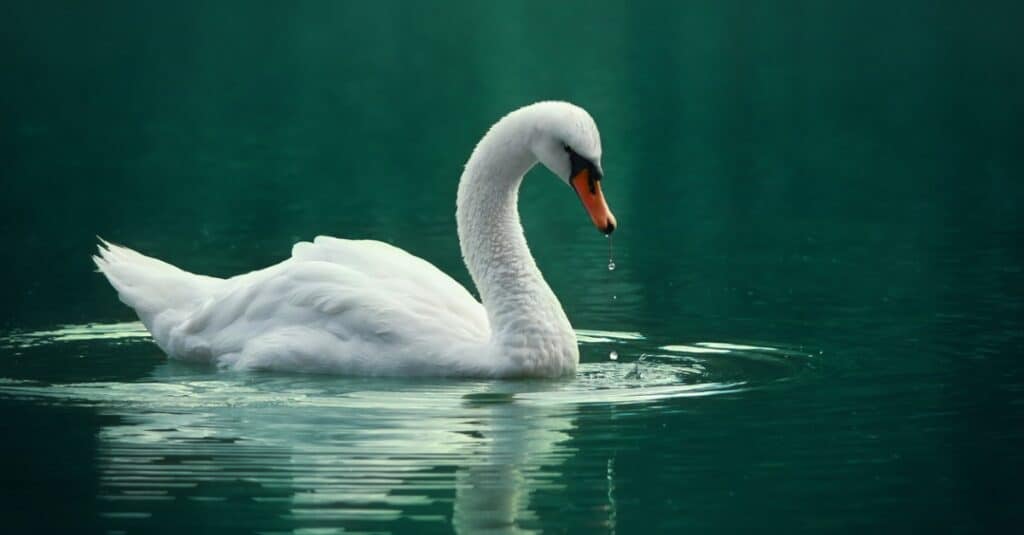
iStock.com/Arina_Bogachyova
Swans are interesting birds for many reasons, but their behavior when looking for a meal is most remarkable. The most common way that swans find food is by grazing on land, where they will obtain suitable food by using their sense of sight which exceeds their capabilities for smelling foods.
When swans find food they like, they’ll use their serrated beaks, not to be confused with teeth, to clamp down and sever plants for consumption. By doing so, they can easily tear off portions of plants and quickly grasp insects.
Since they spend a lot of time on the water, swans do feed when they are paddling along. The way they find food on the water is more interesting than the typical means they use on land. When they spot a plant that they wish to consume beneath the water, swans will start up-ending.
Up-ending is when they dive into the water leaving their feet and posterior exposed and use their long necks to reach down and grab the food they want. Although this leaves them briefly open to attack, it’s an effective way of obtaining foods that few other waterfowl can successfully replicate, owing to their relatively short necks.
What Do Baby Swans Eat?

Sergei25/Shutterstock.com
Swans often mate for life, and they build large nests to house their young. These nests can be up to 2 feet high and 6 feet across. Unlike other birds that are somewhat helpless when they are young, the baby swan, called a cygnet, only needs a day or two to begin accompanying its mother into the water for food.
The mothers will often take them into shallow water and stir it up by paddling their feet, bringing nutritious food closer to the cygnets. During this time, cygnets will eat insects, small mollusks, and freshwater shrimp.
After a few weeks, the young swans start to include more plant matter into their diet before assuming a full diet after the first month. That is when they will begin to eat grass, water plants, and fruits. Shortly after they learn to fly, it’s time to migrate for the colder months, which is something that most cygnets do without their parents.
What Do Swans Eat During the Winter?
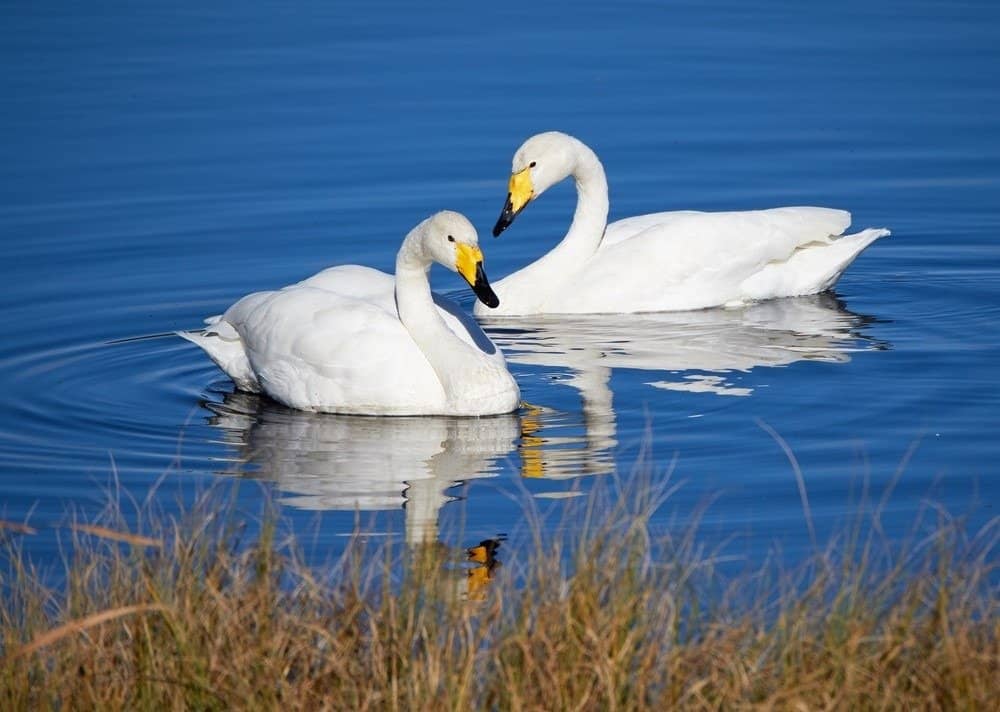
Teemu Tretjakov/Shutterstock.com
Swans are migratory birds, and they head for warmer areas when the winter starts to become severe. They may travel several thousand miles from places as far away as Alaska to the East Coast of the United States.
Along the way, swans will start losing access to a lot of their favorite foods as winter reduces the availability of water plants and the rich foods that grow around ponds and lakes.
The foods swans eat during their migratory times and in winter include:
- Carrots
- Potatoes
- Celery
- Cracked corn
- Grain
- Herbs
- Beetles
- Animal feeds
- Wheatgrass
- Ryegrass
- Cranberries
These foods are in addition to the ones that swans regularly consume. Their typical diet becomes more common the farther south that these birds travel. However, they adapt to their situation, often frequenting large open fields where corn was just harvested or landing in areas with suitable animal feed left in the open.
What Predators Eat Swans?
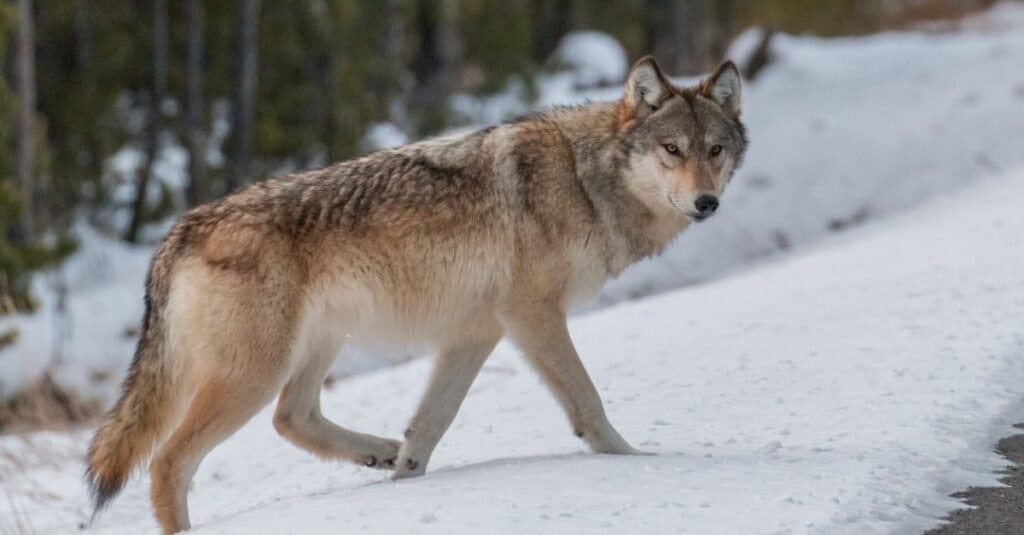
iStock.com/mtnmichelle
Swans are large, territorial birds, but that does not make them immune to predation. In fact, their large size, bright coloring, and willingness to leave themselves exposed while feeding makes them quite an attractive target. The same goes for their young, helpless cygnets.
These are the most common swan predators:
- Wolves
- Red-tailed hawks
- Foxes
- Snapping turtles
- Domestic cats
- Herons
- Raccoons
- Snakes
- Domestic dogs
- Humans
As with most predators, the most successful attacks are those carried out on cygnets. Adult swans will make themselves appear larger by spreading their wings, and they will use their beaks as an offensive measure. However, they are simply not very strong creatures, so enemies that are not scared off stand a good chance of hunting success.
Swans are herbivorous birds prized for their beauty and grace on the water. Their eating habits, while most herbivorous, also include some living creatures, so describing a swan as omnivorous is not entirely incorrect.
These creatures live all over the world, and their migratory patterns make it easy to spot them in far-flung places, especially in the winter.
More from A-Z Animals
Swans are interesting creatures. They are simultaneously famous as a symbol of love as lifelong mates, but they also have a reputation for being aggressive when it comes to defending their nests. Although the swan’s large size gives them an advantage over many other avian creatures, they are not birds of prey that will swoop down on other creatures. Swans are actually herbivorous. With that in mind, we must ask: what do swans eat?
These creatures mostly live in very active biomes comprising lakes, ponds, marshes, and other freshwater areas that are not frequently disturbed. Living in places with such diverse lifeforms puts swans in contact with a variety of potential meals.
Take a look at the foods they are most like to consume, how they find them, and what they need to worry about in the wild.
What Foods Do Swans Eat?

A-Z-Animals.com
Swans eat algae, fruits, grass, and sometimes insects. Swans are mostly herbivorous birds, but a small portion of their diet includes insects, mollusks, and other sea creatures. Swans spend time on land and in water, and they find food in both environments.
Take a look at the most common foods that swans will eat when they are seeking a meal:
- Beetles
- Snails
- Worms
- Algae
- Pondweed
- Wild celery
- Coontail
- Water striders
- Mosquitos
- Dragonflies
- Cracked corn
- Common waterweed
- Muskgrass
- Grain
- Wheat
- Wild Rice
- Arrowhead
- Blueberries
- Freshwater shrimp
Although swans are often referred to as just another herbivore, their diets include some rather unusual elements. They will mostly eat aquatic vegetation because it is very abundant near their native areas. It is easy for them to find a wide variety of plants just by grazing in their local environment in ponds and lakes and around it.
Yet, as the list states, they will seek out foods common to other birds at other times. They eat insects as young, growing swans and turn to wild berries and hearty vegetables when they are available in the winter.
These creatures are very adaptive to adverse conditions.
How Do Swans Find Food?

iStock.com/Arina_Bogachyova
Swans are interesting birds for many reasons, but their behavior when looking for a meal is most remarkable. The most common way that swans find food is by grazing on land, where they will obtain suitable food by using their sense of sight which exceeds their capabilities for smelling foods.
When swans find food they like, they’ll use their serrated beaks, not to be confused with teeth, to clamp down and sever plants for consumption. By doing so, they can easily tear off portions of plants and quickly grasp insects.
Since they spend a lot of time on the water, swans do feed when they are paddling along. The way they find food on the water is more interesting than the typical means they use on land. When they spot a plant that they wish to consume beneath the water, swans will start up-ending.
Up-ending is when they dive into the water leaving their feet and posterior exposed and use their long necks to reach down and grab the food they want. Although this leaves them briefly open to attack, it’s an effective way of obtaining foods that few other waterfowl can successfully replicate, owing to their relatively short necks.
What Do Baby Swans Eat?

Sergei25/Shutterstock.com
Swans often mate for life, and they build large nests to house their young. These nests can be up to 2 feet high and 6 feet across. Unlike other birds that are somewhat helpless when they are young, the baby swan, called a cygnet, only needs a day or two to begin accompanying its mother into the water for food.
The mothers will often take them into shallow water and stir it up by paddling their feet, bringing nutritious food closer to the cygnets. During this time, cygnets will eat insects, small mollusks, and freshwater shrimp.
After a few weeks, the young swans start to include more plant matter into their diet before assuming a full diet after the first month. That is when they will begin to eat grass, water plants, and fruits. Shortly after they learn to fly, it’s time to migrate for the colder months, which is something that most cygnets do without their parents.
What Do Swans Eat During the Winter?

Teemu Tretjakov/Shutterstock.com
Swans are migratory birds, and they head for warmer areas when the winter starts to become severe. They may travel several thousand miles from places as far away as Alaska to the East Coast of the United States.
Along the way, swans will start losing access to a lot of their favorite foods as winter reduces the availability of water plants and the rich foods that grow around ponds and lakes.
The foods swans eat during their migratory times and in winter include:
- Carrots
- Potatoes
- Celery
- Cracked corn
- Grain
- Herbs
- Beetles
- Animal feeds
- Wheatgrass
- Ryegrass
- Cranberries
These foods are in addition to the ones that swans regularly consume. Their typical diet becomes more common the farther south that these birds travel. However, they adapt to their situation, often frequenting large open fields where corn was just harvested or landing in areas with suitable animal feed left in the open.
What Predators Eat Swans?

iStock.com/mtnmichelle
Swans are large, territorial birds, but that does not make them immune to predation. In fact, their large size, bright coloring, and willingness to leave themselves exposed while feeding makes them quite an attractive target. The same goes for their young, helpless cygnets.
These are the most common swan predators:
- Wolves
- Red-tailed hawks
- Foxes
- Snapping turtles
- Domestic cats
- Herons
- Raccoons
- Snakes
- Domestic dogs
- Humans
As with most predators, the most successful attacks are those carried out on cygnets. Adult swans will make themselves appear larger by spreading their wings, and they will use their beaks as an offensive measure. However, they are simply not very strong creatures, so enemies that are not scared off stand a good chance of hunting success.
Swans are herbivorous birds prized for their beauty and grace on the water. Their eating habits, while most herbivorous, also include some living creatures, so describing a swan as omnivorous is not entirely incorrect.
These creatures live all over the world, and their migratory patterns make it easy to spot them in far-flung places, especially in the winter.

